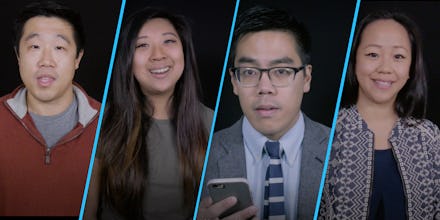South Asians, Filipinos call out lack of inclusion in 'Times' video about racism

On Thursday, the New York Times published a video about the racism that Asian-Americans face every day, a compilation of stories gathered from the hashtag #ThisIs2016.
The video was a follow-up to an earlier Times article from editor Michael Luo, in which he responded to a person on the street who told him to "go back to China."
Unfortunately, according to some Asian-Americans, the video erased the complex reality of the United States' Asian population by featuring people of East Asian descent almost exclusively, with one self-identified Filipino American represented and no South Asians.
Several Asian Americans penned open letter, published on the Huffington Post, which reads:
Your video told us, "You're still invisible!"
Dr. Kevin Nadal, a trustee of the Filipino American National Historical Society and author of Filipino American Psychology, co-signed the open letter. He said he was "shocked" when he watched the video.
"I saw one East Asian face after the other, until one woman appeared and disclosed she was Filipina," Nadal said in an interview. "And when I finished I was shocked. No South Asians at all? How the hell were they not included."
This is not the first time the Times has left Filipinos and South Asians out of the equation. The Times produced a roundtable video earlier in April entitled "A Conversation With Asians on Race," and among the 37 participants in the two videos, only one was Filipina and five were South Asian.
The video did not accurately show how these groups are represented in society, as Filipinos are 19% of the U.S. Asian population and South Asians represent 18% of all Asian-Americans.
Anthony Ocampo, assistant professor of sociology at California State Polytechnic University and author of The Latinos of Asia: How Filipino Americans Break the Rules of Race, created a graph comparing the demographics of Asian-Americans versus how often the Times represents them in coverage.
Several Asian-Americans shared their feelings about the video on Twitter as well.
Ali Mattu, who identifies as South Asian and is an associate professor at Columbia University Medical Center, also co-signed the open letter addressed to the Times. He said he was excited to watch the video, then slowly realized that no South Asians were featured.
The exclusion of brown Asians is probably because, Mattu said, Filipinos and South Asians are often not considered to be Asian.
"When you say the words 'Asian-American,' to most people the experience that typically comes up doesn't reflect the experiences of South Asians or Filipinos."
Mattu said that may cause a cyclical problem — the more South Asians feel excluded from the term "Asian-American" the more they may choose to exclude themselves.
"A lot of brown Asians don't necessarily identify as Asian-American and may not join groups or causes that they see as not really representing them," Mattu said. "They don't see faces and experiences and voices and languages that reflect their experience."
In a statement to Mic, Luo said that the lack of Filipino and South Asian faces is a "legitimate shortcoming" of the video.
Luo said that the Times "felt a lot of urgency" to produce the video while the hashtag was still trending.
"In the end, only a subset of people got back to us by the end of the day," Luo said in his statement. "Unfortunately, that group did not include any South Asians and only one Filipina."
He added, "It should be pointed out that the response to the open letter and the #ThisIs2016 callout in that first day or two was overwhelmingly East Asian because so many of them related to the insult, 'Go back to China.' Just by way of example, only 20 out of 1243 comments on the open letter were South Asian and only one of them was from New York City. We, of course, wish that the video could have included South Asians, who have experienced some of the harshest forms of racial backlash in recent years after the Sept. 11 attacks. We aim to do better next time."
According to Nadal, this exclusion of brown Asians has historical roots: East Asian-Americans began a "yellow power" movement during the 1970s, which mirrored the black power movement. Filipino Americans who felt excluded by the term "yellow power" either had to splinter off into "brown causes" or align with Latino movements.
"Brown Asians are often told by East Asians that they're 'not Asian enough' or that they should align with another category," Nadal said.
Brown Asians are often told by East Asians that they're "not Asian enough" or that they should align with another category.
Both Nadal and Mattu said that, more so than just being upset with the Times coverage, they felt that this was another manifestation of colorism and anti-brown sentiment in the Asian community. This sentiment, Nadal said, is a remnant of colonialism in Asian countries.
"Many Asian countries were colonized by some European entity, who taught them that their indigenous ways or physical looks were inferior," Nadal said.
The effects are still around.
"There's a really popular cream called Fair and Lovely, where the idea is to try to make your skin a lighter color," Mattu said. "This idea that lighter is better is a big problem in the Asian-American community."
When asked what they would've included in the video if they had been asked to participate, Mattu said he would've talked about the rise in anti-South Asian violence since 9/11, while Nadal said he would highlight how many other Asian-Americans have told him he was not Asian because of his Filipino identity.
Luo also pointed out that an earlier conversation on Asian-Americans and race included several South Asians. The Times also hosted a live chat about Asian-Americans and race on their homepage on Tuesday, Oct. 18.
Oct. 18, 2016, 10:46 p.m.: This story has been updated.